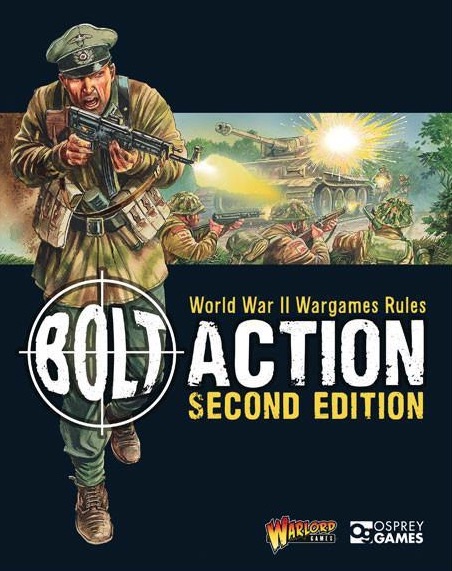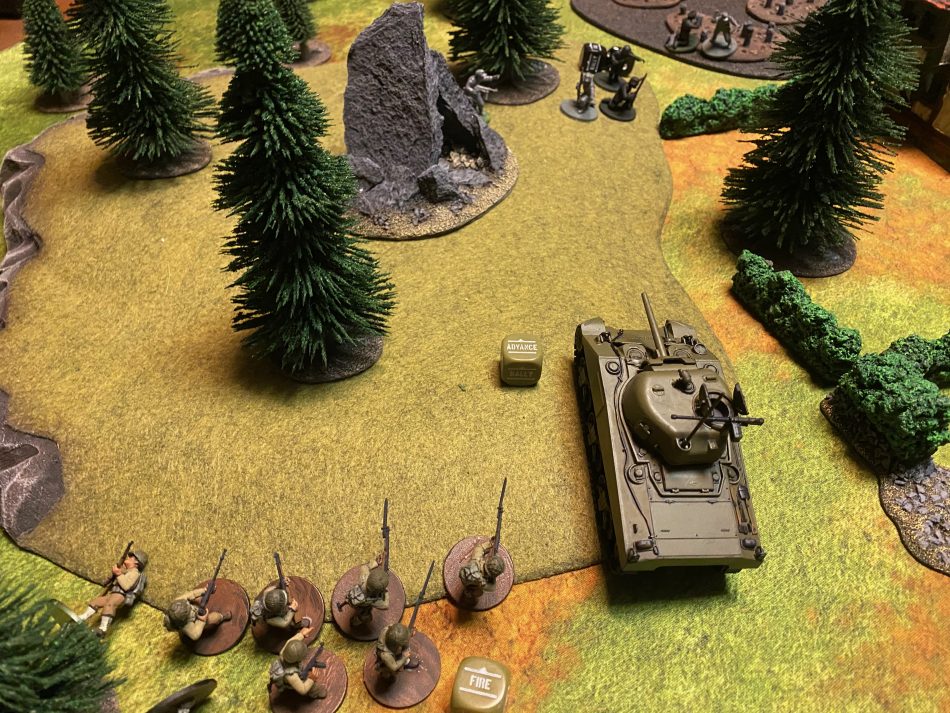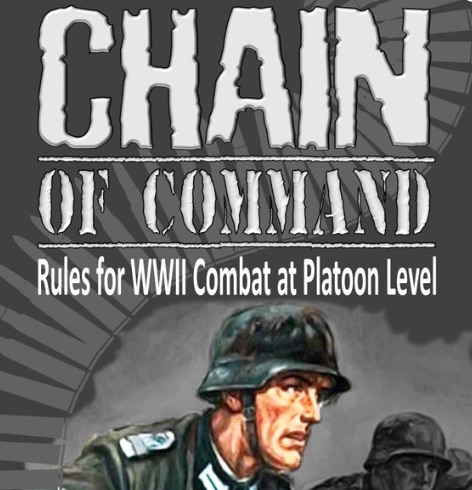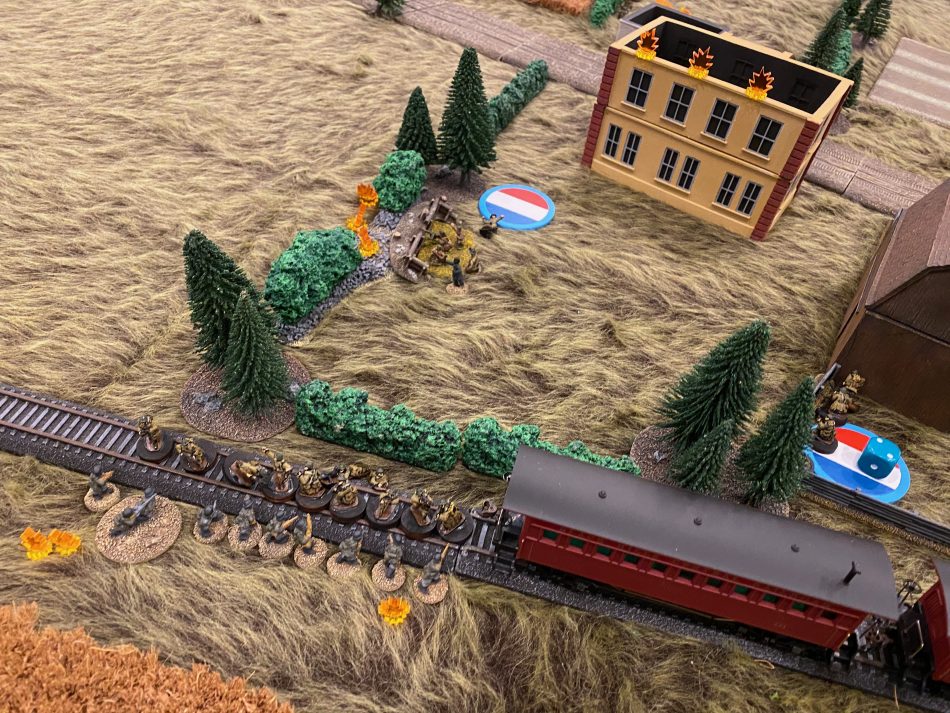A Survey of WWII Rulesets Part 2
Editor’s note: this story was originally published September 2020, and is presented again for your enjoyment.
By Tom Gall
There are a good number of quality WWII rulesets in existence, let’s explore some of these rules, point out what their strong/weak points are and compare what might draw you to one over the other.
The rulesets considered in this article are : (FOW) by Battlefront, by Too Fat Lardies, by Warlord, by Plastic Soldier Company.
Each of these rules is generally company level actions with support, for the most part, feature individual models, and focus on the WWII era. All are D6 based. All have extra material that offer campaign experiences, lists, and flavor to feel like you’re been given command with a battle to win. All are either point costed and/or have a list building system which makes it easier to put together a game.
This week, we’ll look at two of the four: Bolt Action and Chain of Command. The other two systems will follow were published here.
 – Warlord
– Warlord
Bolt Action (BA) is not a U-go-I-Go system. Instead, it uses a bag of colored dice, where the color of the dice determines which side will activate a unit.
Upon having a die drawn for their side, a player chooses a unit to activate, and assigns one of six orders to the unit (Fire, Advance, Move, Ambush, Rally, or Down)
If a unit is given an ambush order, it is set to fire upon any unit that moves within it’s field of fire. This allows one side to interrupt the action of the other. The ambush order remains on the unit until you decide to take them off ambush (put the die back into the bag for random draw).
The activation system in BA is unique and makes for a dramatic game. Given you have a 1:1 mapping of dice to unit activations everything will get activated through the course of a turn, it’s just a matter of when the dice for each side is drawn. The slight downside to this style of activation is the more units you have over your adversary it increases the likelihood you’ll activate first.
Combat is D6 based. A roll to hit, if successful, generates a roll to wound/kill. Modifiers are generally minimal with a base 3+ being what you need to hit. If you are able to score a hit against infantry the target rolls a save which is a function of the quality of infantry, or the armor value of the AFV.
Veteran get a 3+ save, while Inexperienced have a 5+. Tanks, mortars, Howitzers, and the like have their guns put into categories for their effectiveness. Likewise, armor ratings for AFVs have a more limited set of categories than some of the other systems.
To score a penetration you’ll need to meet or exceed the armor rating. Weapons which can penetrate armor have a + (plus) rating to their effectiveness. A Sherman has a damage value (DV) of 9+ and will need to be shot at by a weapon that has at least a +3 penetration (a roll on a d6 of 6 plus the 3 of the weapon is the minimum needed to penetrate the armor rating).
A German Hetzer with it’s AT gun is a +6, which gives it some punching power.
If the shot penetrates you roll on a table to determine the damage, which might be nothing all the way up to brew up. Modifiers apply here depending on if you meet the DV of the tank or exceeded it significantly.

When assembling a force for BA, you’ll generally be running a platoon-sized force plus attachments. Forces are point costed with lots of flexibility. You’re usually able to pick the experience level of the unit which is a strong influence on the cost. Experience level also equates to the unit moral. , it is free to use.
When you issue an order if you have received pin markers (from taking fire) that unit needs to pass a test to see if it can receive an order. If it fails the unit does nothing. Each pin marker is a minus. Having a leader nearby gives you a bonus based on their quality.
Bolt Action has a very good selection of army books to choose from as well as campaign guides. Warlord further has numerous kits supply you with 28mm figures. Unlike other games, where point costs for a type of weapon, or Armoured fighting vehicle may vary between periods, BA uses a Theatre Selector system to provide variation. The core system includes an Armies of … book for each of the major powers (Germany, Japan, USA, British, and the Commonwealth, and Russia), and collects minor powers into several other books.
Their theatre books serve as an excellent campaign source. Most of these tomes have a well-detailed series of missions that players can work through in whole or in part. They can also be adapted to club play. Each theatre book includes new limits/maximums on units that can be taken based on historical representation in those battles.
Bolt Action does have an active tournament scene in both the USA and Europe. Like FOW, if you’re eager to get out and pit your skills against others in competitive play, the Bolt Action community has it.
 – Two Fat Lardies
– Two Fat Lardies
Chain of Command (CoC) is a platoon-sized game with each side usually having some set of variable attachments selected off a menu.
The game does not have a set model scale, with 15mm, 20mm, 28mm all being used. As the game is platoon based, most seem to gravitate to the larger scales. Figures are individually mounted.
The game has several unique mechanics. The game starts with a patrol phase. The outcome of the phase sets up where your jump-off points will be. Jump points, as per the name, are where your force will deploy from. These positions also need to be defended, as if they are lost, it counts against your unit morale.
Chain of Command uses a command dice pool. For most forces, this is five dice (d6s). Roll your command dice pool at the beginning of your turn. Each die rolled is applied individually, or combined to pass on an order to your troops (a one and a two may be combined for result of three).
- A roll of one allows you to activate a team.
- A roll of two activates a squad.
- A roll of three is a junior leader who then can active a squad, or uses some of their leader abilities.
- A roll of four activates a senior leader.
- A roll of five builds up a chain of command dice, that once you have rolled 6 5’s give you special abilities.
A single six on your command dice roll gives you nothing. Two 6s, however, allow you to activate twice in a row. This type of activation system leads to a quick back and forth between the two sides where a little luck helps you activate the forces you need with the limited options you’ll have. Often you won’t have enough command dice to activate all of your forces on the table. You’ll have to focus to bring about a victory.
Chain of Command is won through scenario victory conditions or by breaking the morale of your opponent’s force. Loss units, or your opponent capturing a jump-off point, and a number of other factors results in a roll on the When Bad Things Happen table. Each roll may result in a drop in your force morale. If it falls too low you’ll start to lose command dice. if it goes to zero, you’ve lost the day.

Shooting is D6 based, with a limited set of modifiers to hit. The target, if hit rolls saves depending on the cover they are in which might result in nothing, a pin marker or a kill. CoC uses firepower factors where a single rifle will add 1 D6 to the pool, and machine-guns 5 or more. Both BA and CoC emphasize the squad machine-gun which was the critical tool as part of squad tactics in WWII.
Shots against armor utilize a system where the a successful hit, allows the shooter to roll a number of dice equal to the capabilities of the weapon. The target rolls a number of dice based on their armor value.
If the target rolls more successes then the person that scored the hit, nothing happens. However, if the firer scores more successes, then a table is consulted. Results for the target get worse depending on the number of successes the shooter had. The number of dice the shooter rolls in this step is also a function of the range.
Chain of Command has a wonderful set of campaign rules called At the Sharp End which is used in a large number of campaign books. Within a campaign setting, leaders can advance, wounded, replacements etc matter.
There is no online force builder for CoC, but it’s not needed. The core rulebooks give you what you need in order to field a force, plus attachments. If you really want to try your hand at putting together your own custom lists the official CoCulator is online and is the basis for many fan created material.
There is not a tournament scene for Chain of Command. The collection of supplements and campaigns is extensive and gives a player many future fun games to draw on. The campaign system “At the Sharp End” is very well done and makes it fair easy for you to put together your own campaigns.
Comparisons
If you’re looking for a fun set of WWII rules, all 4 presented are good options. I recommend them all. The qualities you look for in a game however are what you want to base your decision on.
Is it cost? Bolt Action has nice starter armies for approx $150, Flames of War will require a larger investment as you’ll need several units in order to fill out a force, and last Chain of Command and Battlegroup, only require what you would field. Chain of Command is fairly modest, if played in 15mm, $100 will get you not only your central force but plenty of options too. Battlegroup is somewhat akin to Flames of War where Battalion sized games will need more figures but akin to Chain of Command where if you select 15mm as a scale for your forces, a platoon sized game can be had for a modest investment. No matter the game system you choose, you’ll need to budget for books.
Is it history? Battlegroup, Bolt Action and Chain of Command all offer experiences more tied to historical settings. Their campaign books and support material is all very good. Flames of War has theatre based material, however since moving to v4 the force design is less historical in nature.
Is it flavor in the rules? Battlegroup and Chain of Command are better choices here, with Battlegroup having the most to offer, with vehicle stats, better thought out rule mechanics to reflect tactics in use, and all around attention to detail. Chain of Command offers a slightly less detailed experience at platoon scale. Bolt Action and Flames of War offer more simplicity in their mechanics but this is also easier for new players to pick up.
Is it a tournament setting? Bolt Action and Flames of War absolutely shine here. Both have active organized play communities which gives you an avenue to meet other players with similar interests as well as a place to hone your skills, learn every aspect of the rules and satisfy your competitive ambitions.
Is it miniatures? All four games are mostly equivalent. Flames of War and Bolt Action offer their own branded solutions that give you exactly what you need to play the game. Flames of War in 15mm scale and Bolt Action in 28mm scale. Battlegroup and Chain of Command give you the freedom to pick what you want, but with this comes the responsibility of having to reference the army lists and seek out what you need.
Is it flexibility? Maybe you want to play as many rulesets as possible reusing the miniatures between them. If you go with 15mm miniatures, Battlegroup, Chain of Command and Flames of War will be generally compatible. The sticking point will be infantry where Flames of War wants infantry mounted in teams on a base, where Chain of Command wants individually mounted infantry. Vehicles are entirely the same no matter the rules. If you want 28mm, Bolt Action and Chain of Command will be entirely compatible with each other from a figure perspective. Battlegroup can also be played in 28mm, but you’ll play smaller games unless you have a nice size game table and you’ll want to increase the range bands.
Opinions
All 4 of these rulesets I am invested in and play. Locally the most popular of the bunch is Flames of War with Chain of Common and Bolt Action next in popularity. Battlegroup, I wish more would play but I find if I put on a Battlegroup game, people show up eager to play. The dynamics of what gets played is always an interesting one!
Flames of War has the draw where it is so very easy to setup and play a game to a conclusion in the course of ~2 1/2 hours, it seems to make it the default go to. This fits in well with an evening gaming experience at the FLGS. Given the set of scenarios, the force building, the stat cards, players don’t need to invest in much effort to plan a game. The tournament scene is active and offers a way to meet even more people who have similar interests.
Chain of Command and Battlegroup both offer richer experiences. More in-depth rules, more flavor, a deeper connection to the historical aspect which for some is an important characteristic. Chain of Command for platoon level actions and Battlegroup for larger games is my dividing line. When I’m playing campaigns or try to recreate historical situations, Chain of Command and Battlegroup both have served me well.
Bolt Action is akin to Flames of War, it’s fairly easy to show up with a point costed force and play a game in the course of a couple of hours. Bolt Action with its campaign / theatre based books also brings historical flavor for the setting even if the armor rules are a bit more abstract. Locally this is the game that is currently gaining interest.
No matter what you choose, or the criteria you might have, I believe all 4 of these rulesets are well worth your time. I’m eager to hear about the rules you play for WWII and why in the comments.

I whis it was still true with Flames of War Tournaments for Germany. There is sady no germany community anymore.
You didnt mention availability of product. I realize not a rules issue but its killed FOW in many locations.